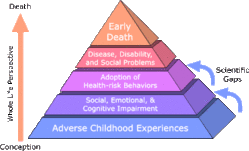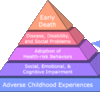I remember the first time I filled out the ACEs questionnaire. I was horrified to discover that I was in the “four or more” category, with all kinds of negative health and mental health outcomes on my horizon. As you can guess, it wasn’t delivered in a particularly trauma-informed way, and I was completely dysregulated by my results. Other participants were remarking on their “zero” category, which only increased my discomfort. I remember leaving the room wondering what was the point of telling people in the “four or more” category if our inevitable end would be “early death?”
Fast forward to today – there are many resources available online about resilience, and how people with multiple ACEs overcome these risk factors and go on to live vibrant, happy lives. In fact, the home page of ACEs Connection today has stories right up front about resilience. I’m glad to see it, and hope that it continues in that way. Still, I was recently in a school where I heard someone doing an ACEs talk and found myself startled and disconcerted when the presenter landed hard on the “early death” part of the pyramid. I hoped that they would circle back and remind everyone about resilience and possible mitigating factors, but they never did. I commented on resilience factors during the Q&A section, but as a person speaking from the audience people may or may not have taken my comments seriously.
Last year I was asked to testify at the State Capital for a bill (AB 2701) that would provide for addressing trauma in schools and was able to be in the room during discussion for another bill which focused on ACEs. In that discussion it was suggested that all kindergarten children be screened for ACEs – perhaps by their primary care physician at the wellness check they need to have in order to enroll. The Assemblyman who was facilitation the discussion posed this hypothetical situation:
“Let’s say you have 4 kindergarten classrooms, with 25 kids in each class. If we screened them all and ¼ have 4 or more ACEs, does it then mean we need to provide therapists to for 20 kids?”
One of the people sponsoring this bill (not a mental health practitioner) said, “Yes.”
Once again, I was taken aback with the way ACEs was being utilized. I know other people (Andrew Turner, for instance) have already spoken quite eloquently here about the problems associated with this kind of blanket screening, suffice it to say there are some problems. One problem, would be this assumption that they would all need therapy.
As you can see, my relationship with ACEs is complicated. I am glad that the information exists and has become so well known, and I’m concerned about how it sometimes gets thrown into the mix with very little finesse. My work is closely related, addressing trauma in children and the impact that trauma may have on their educations, so it comes up regularly. I’m interested in connecting with folks about how it has shown up in your work and lives.




Comments (0)